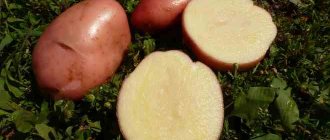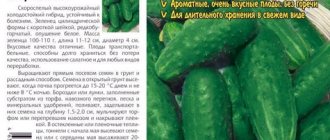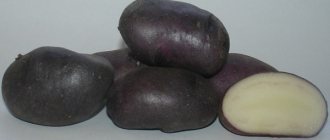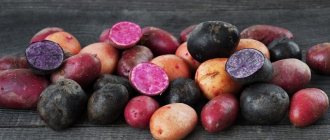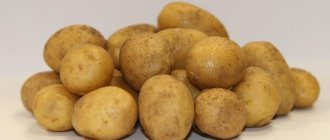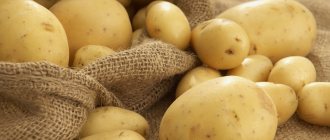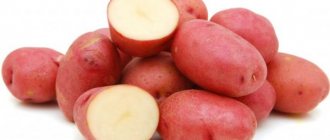Description of tomato variety Lyudmila with photo
Tomato Lyudmila is a first generation hybrid (F1), bred by amateur breeders. Suitable for growing in all regions of Russia in protected soil conditions (greenhouses, greenhouses). In the Krasnodar Territory, the North Caucasus and other southern regions, they can be bred without shelter.
Main characteristics of the tomato variety Lyudmila:
- indeterminate (grows throughout the season);
- tall (120-150 cm);
- early ripening (95-100 days).
The Lyudmila tomato bush is tall, with powerful stems. The leaves are large, grassy green.
Important! Hybrid Lyudmila has good resistance to temperature changes. Even at 15 degrees, the bushes continue to form ovaries and bloom.
If prolonged night frosts are possible, the seedlings should be transferred to a greenhouse.
Description of fruits
Hybrid Lyudmila F1 produces round tomatoes, flattened at the top and bottom. Slight ribbing is visible on the surface. The fruits are quite large, on average 150-200 g, some specimens up to 250 g, up to 7-8 cm in diameter. Unripe fruits are colored light green, there are no spots on the stalk. Ripe tomatoes acquire a classic bright red color. The taste is excellent, balanced - the ratio of sugar to acid is 3:1.
Lyudmila tomatoes are very juicy, have 4-6 chambers with seeds. There are no voids, which can be seen in the cut. Also, tomatoes do not have a green trace from the stalk - they are completely red both outside and inside. This allows them to be used in a wide variety of dishes, including making juices and tomato puree.
Lyudmila tomatoes have a very good taste with an optimal balance of sour and sweet
Tomato "Budenovka": description and characteristics
The berries are no more than 20 grams, round, yellow in color. When ripe they have a sweetish taste. Even in the photo it looks tempting:
Long Keeper tomatoes:
Characteristics of tomato Lyudmila
Lyudmila tomatoes ripen 3-3.5 months after germination. Therefore, they are usually sown a month before the intended transfer to open ground. The first fruits can be harvested in mid-June (in the south - at the end of May).
Tomato productivity Lyudmila and fruiting
The hybrid has a fairly good yield. If you follow the correct agricultural techniques and grow in greenhouse conditions, you can harvest up to 4 kg of tomatoes from 1 bush.
| Conditions | Greenhouse | Open ground |
| From 1 bush, kg | 3-4 | 2-3 |
| From 1 m2, kg* | 9-12 | 6-9 |
*You can plant 3 Lyudmila tomato bushes per 1 m2, preferably in a checkerboard pattern.
Area of application of fruits
The Lyudmila tomato has a universal purpose. The fruits can be used fresh or canned to prepare various dishes:
- salads;
- sauces;
- soups;
- puree;
- juice;
- tomato paste;
- canned vegetables (lecho, adjika and others);
- whole-fruit canning (salting, pickling).
Advice! Since the skin of Lyudmila tomatoes is quite dense, for preparing hot dishes (sauces, soups), the tomatoes can first be kept in boiling water for 2-3 minutes. Then the skin can be easily removed.
Resistance to diseases and pests
The disease resistance of tomato Lyudmila is satisfactory. However, the risk of late blight and root rot cannot be ruled out. Therefore, it is necessary to regularly ventilate the greenhouse and not water it too much. For preventative purposes, seedlings must be treated with any fungicide a few days before transplanting.
Tomato Lyudmila: characteristics and description of the variety, reviews, photos, yield
Tomato Lyudmila is a hybrid variety of universal-purpose tomatoes. It has good yield: when grown in a greenhouse, you can get up to 4 kg of very tasty fruits from 1 plant. Moreover, the first tomatoes ripen in June.
Description of tomato
The description of the “Lyudmila” tomato (shown in the photo) is based on reviews from vegetable growers who grow the variety in different climatic zones. The crop is not included in the State Register, so there are no detailed characteristics and recommendations for agricultural technology.
Tomatoes "Lyudmila" are mid-early. From the moment the seedlings are planted in the ground until the first harvest is harvested, 3.5 months pass.
A tomato with unlimited growth, but does not produce a large number of side shoots, which is not typical for indeterminate varieties.
Through selection, the “Lyudmila” tomato is adapted to differences in night and day temperatures. At a temperature not lower than +150 C on exhaust gas, flowering continues, there is no loss of ovary. The culture tolerates lack of watering within 5 days.
Description of the variety "Lyudmila":
- The bush is formed by two trunks, one is the main one, the second is a strong stepson from the first circle of leaves. The tomato stems are thick, brown with a green tint, the structure of the trunk is woody. The height of the tomato variety “Lyudmila” reaches two meters; in greenhouse structures the height is limited to 1.5 m, in an unprotected area - 1.2 m.
- The plant produces few side shoots; they are removed during the growing season. The foliage of the bush is strong, the leaves are rich green, densely pubescent on the underside. The leaves are long, narrow, corrugated with pronounced uneven edges.
- The “Lyudmila” variety is self-pollinating, blooms profusely with yellow flowers, 95% producing ovaries.
- The first fruit cluster begins after the 5th leaf, the second and the rest after 3. The first cluster is filled with up to 7 tomatoes, on the next branches there are fewer ovaries, the minimum filling is 4 fruits on the last circle.
The root system of the “Lyudmila” tomato is not characteristic of an indeterminate variety: the root circle is wide, like a surface system, while at the same time the roots go deep. This structure provides the tomatoes with a sufficient amount of nutrition; the tomato can do without watering for a certain time.
Characteristics of tomato
The zoned variety “Lyudmila” is adapted to the weather conditions of the target growing region. A variety was created for cultivation in temperate climates, unheated greenhouse structures. The tomato tolerates low temperatures well and is undemanding when it comes to watering.
Productivity and fruiting
Tomato varieties with unlimited growth are characterized by high yields. The tomato "Lyudmila", shown in the photo, according to reviews, is no exception. The method of forming a bush - with two trunks - allows you to relieve the main stem and increase fruiting.
The first harvest occurs on the 110th day after planting the seedlings, approximately the second half of July. 4.0 kg of tomato is picked from one bush, 3 plants are placed per square meter, and planted in a checkerboard pattern. At the end of the season, up to 12 kg are obtained from 1 m2.
The amount of fruiting in the exhaust gas is affected by excess ultraviolet radiation; plant photosynthesis does not require excess light. In direct sunlight, the growing season slows down. In greenhouses, waterlogging of soil and air can provoke fungal and bacterial infection of tomatoes.
Advantages and disadvantages of the variety
The tomato variety "Lyudmila" has the same disadvantages as all indeterminate types. The plant is tall and requires support and tying. Mandatory formation of the bush, pruning of dry leaves and brushes after fruiting, removal of stepsons.
Advantages of tomato:
- excellent taste;
- convenient fruit size;
- versatility of using tomatoes;
- drought resistance;
- good tolerance to sudden changes in temperature;
- When propagated in greenhouses, it does not require additional lighting.
Tomatoes are well preserved, ripen successfully, and are easily transported.
Growing rules
The Lyudmila tomato is not a hybrid, so planting material is collected from the parent plant. Seeds are stored for three years and do not lose germination and varietal characteristics. The tomato variety "Lyudmila" is planted as seedlings.
Planting seedlings
Planting material is sown in mid-February - early March. To do this you need:
- Prepare soil consisting of three equal parts: humus, peat, turf soil.
- Spread the soil into containers 20 cm high or higher.
- Pour in warm water and make furrows 1.5 cm deep.
- Place one seed per 1 cm.
- Cover with soil mixture.
Cover the top of the container with glass or film and remove it to a shaded place before germination. When young tomato shoots appear, the covering structure is removed. Water the plant as needed. Take it to a bright place to grow. When the seedlings of the “Lyudmila” variety reach 15 cm and 5 leaves are formed on the trunk, they are dived into separate glasses or a large container.
Tomato transplant
Tomato seedlings are transplanted into a protected place 1.5 months after sowing, approximately in April. In OG, tomatoes are planted taking into account that the soil has warmed up to +140 C and there is no threat of frost (in mid-May). For the greenhouse and open area, the distribution scheme is the same. Three tomatoes per 1 m2 in a checkerboard pattern.
Subsequent care for tomatoes
The “Lyudmila” variety requires fertilizers for fruiting:
- complex - for feeding seedlings;
- phosphorus - at the time of flowering;
- potassium - during fruit ripening.
The bushes need shaping and pruning of the resulting stepsons. Be sure to remove the brushes from which the harvest has been harvested, as well as trimming old, dry leaves along the entire trunk.
Since tomatoes require garter, install a trellis or support. Water the tomato after the root circle has dried. Water lightly with warm water. The “Lyudmila” variety does not like waterlogging of the soil and air. On open ground, mulching with peat is recommended. Preventative treatment helps protect bushes from pests and insects.
Advice! In greenhouses, for gartering, they use a structure consisting of high metal poles, which are dug in every 2 meters. Between them they stretch a wire to which the tomatoes are attached.
Reviews
Tamara Sergeevna Svetlova, 40 years old, Nizhny Novgorod, planted the “Lyudmila” variety for the first time this year; I didn’t know about it before. I was satisfied and reaped a good harvest. The taste of the tomato is sweet with a slight presence of acid. The size of the fruit is convenient for canning. Sergeev Ivan Vasilyevich, 60 years old, Chelyabinsk I have been growing the variety at the dacha for the second year, the ripening time is fine. At the end of August, ripe tomatoes are on the table. I leave the bushes 1.8 m high, tie them to a wire stretched on a trellis, and form a bush with one stem. The yield is good. Irina Semenovna Zinovieva, 55 years old, Minusinsk, I recommend the “Lyudmila” tomato variety to everyone, I am a longtime fan of it. For Siberia, this is the most unpretentious variety that tolerates low temperatures well. The fruits are tasty and medium in size. I have 30 bushes, which is completely enough for winter preparations.
Source: https://AgroGnom.ru/vegetables/tomatoes/tomat-lyudmila.html
Advantages and disadvantages of the variety
Tomato Lyudmila is grown in almost all regions. Summer residents appreciate it for its very good taste and stable yields. In addition, the agricultural technology is simple - both experienced and novice gardeners can grow bushes.
Lyudmila tomatoes have a balanced taste and pleasant aroma
pros
- good yield;
- excellent taste;
- good drought resistance (withstands lack of watering and heat for at least 5 days in a row);
- resistance to changes and short-term decreases in night temperatures;
- low maintenance requirements;
- good keeping quality and transportability.
Minuses
- the need for stepsoning;
- the need for tying to a support;
- average resistance to diseases.
Care plan
Caring for the Lyudmila variety includes watering, loosening the soil and fertilizing. Extra stepsons must be eliminated. To form an even stem, tomatoes are tied to a support. According to reviews of the Lyudmila tomato, this variety is unpretentious.
Watering and loosening
Tomatoes are watered taking into account weather conditions. Soil moisture is maintained at 80%. With a lack of moisture, the tops turn yellow and the inflorescences fall off. Its excess also negatively affects plants, which develop much more slowly.
It is best to carry out the procedure in the morning or evening to avoid direct exposure to the sun. Due to this, burns on plants and increased evaporation of moisture can be prevented. Tomatoes prefer dry air, so the greenhouse is constantly ventilated.
On average, tomatoes are watered once or twice weekly. A tomato bush requires 3 liters of water. During the flowering period, it is enough to water the plantings weekly, but the volume of water must be increased to 5 liters.
Important! Tomatoes are watered with warm water that has settled in barrels.
After watering, the soil must be loosened. The procedure improves air exchange in the soil, due to which plants better absorb water and nutrients.
Feeding tomatoes
Regular feeding contributes to the normal development of tomatoes Lyudmila. This crop prefers phosphorus or potassium fertilizers. Phosphorus strengthens plant roots, and potassium strengthens the immune system and improves the taste of fruits.
Advice! Nitrogen fertilizers can only be applied at an early stage of tomato development, since they are responsible for the growth of tops.
For the first treatment of tomatoes, Lyudmila prepares a solution containing superphosphate (40 g) and water (10 l). The solution is applied at the root of the tomatoes.
After a week, the tomatoes can be fed with potassium sulfate (30 g) dissolved in a large bucket of water. The resulting solution should be poured over the tomatoes.
When forming inflorescences, Lyudmila tomatoes are sprayed with boric acid. Add 5 g of this fertilizer to a 5-liter bucket of water.
You can replace minerals with wood ash, which contains a complex of useful substances. It is embedded in the soil when loosening tomatoes or an infusion is prepared for watering plantings.
Pinching and tying
The Lyudmila variety is tall and therefore requires pinching. As the tomatoes develop, you need to eliminate the shoots that appear from the leaf axil. The procedure allows you to avoid crowding the beds and direct the tomatoes’ energy to fruit formation.
The tomatoes are tied at the top to a metal or wooden support. To prevent branches with fruits from falling to the ground, they also need to be secured.
Features of cultivation
Tomato seedlings Lyudmila can be transferred to open ground within 30-35 days after germination. Therefore, in the south it is sown at the beginning of March, and in the middle zone - at the end of the month. In the Urals, Siberia and other regions with cool summers, seeds can be planted in the first half of April.
Seeds must be purchased at the store. Store for quite a long time - they remain fresh for 3 years in a row. Tomatoes are bred in 2 ways:
- Rassadny is traditional for most regions of Russia.
- Without seedlings - planting in the ground at the end of April (under film) - acceptable for the southern regions.
Seeds are planted in cassettes, boxes or individual containers - for example, in peat pots or disposable glasses. Can be grown in universal soil for seedlings. Summer residents also make up the mixture themselves - 2 parts of turf soil and 1 part each of compost and humus. An alternative option is 1 portion each of peat, humus and garden soil. You can also add a few pinches of sand and wood ash.
Tomato seedlings Lyudmila are convenient to grow in individual containers
Growing instructions are as follows:
- Disinfect the soil by holding it in a weak solution of potassium permanganate or hydrogen peroxide, and then rinsing it under running water.
- Soak the seeds in a solution of “Kornevin” or another stimulant.
- Plant to a depth of 1.5 cm at intervals of 1 cm. Sprinkle with soil.
- Moisten generously, cover with a lid or film with holes.
- Place in a warm place (temperature 23-25 degrees).
- If the lighting is not enough, it is advisable to add light with a phytolamp for up to 12-13 hours a day.
- You need to dive after the first leaf appears.
- Gradually reduce the temperature to 20-22 degrees.
- 2 weeks before transferring to the greenhouse, harden at a temperature of 16-18 degrees.
The seedlings are transplanted into open ground in mid-May, and into the greenhouse a week earlier. The planting pattern is staggered, maintaining a distance of 60 cm between rows, 40 cm between adjacent bushes. Further standard care:
- Regular watering 2 times a week.
- Fertilizing every 2-3 weeks (complex mineral fertilizer).
- Spraying with a solution of boric acid (1 g per 1 l) during the formation of inflorescences.
- Mulching the soil with peat, sawdust, hay.
- Periodic loosening of roots and weeding.
- Pruning - removal of all side shoots.
- Since the bush is quite tall, it also needs to be tied to a support.
To obtain a good harvest, tomato seedlings Lyudmila must be placed in a checkerboard pattern
Growing rules
The Lyudmila tomato is not a hybrid, so planting material is collected from the parent plant. Seeds are stored for three years and do not lose germination and varietal characteristics. The tomato variety "Lyudmila" is planted as seedlings.
Planting seedlings
Planting material is sown in mid-February - early March. To do this you need:
- Prepare soil consisting of three equal parts: humus, peat, turf soil.
- Spread the soil into containers 20 cm high or higher.
- Pour in warm water and make furrows 1.5 cm deep.
- Place one seed per 1 cm.
- Cover with soil mixture.
Cover the top of the container with glass or film and remove it to a shaded place before germination. When young tomato shoots appear, the covering structure is removed. Water the plant as needed. Take it to a bright place to grow. When the seedlings of the “Lyudmila” variety reach 15 cm and 5 leaves are formed on the trunk, they are dived into separate glasses or a large container.
Tomato transplant
Tomato seedlings are transplanted into a protected place 1.5 months after sowing, approximately in April. In the exhaust zone, tomatoes are planted taking into account that the soil has warmed up to +14 0 C and there is no threat of frost (in mid-May). For the greenhouse and open area, the distribution scheme is the same. Three tomatoes per 1 m2 in a checkerboard pattern.
Subsequent care for tomatoes
The “Lyudmila” variety requires fertilizers for fruiting:
- complex - for feeding seedlings;
- phosphorus - at the time of flowering;
- potassium - during fruit ripening.
The bushes need shaping and pruning of the resulting stepsons. Be sure to remove the brushes from which the harvest has been harvested, as well as trimming old, dry leaves along the entire trunk.
Since tomatoes require garter, install a trellis or support. Water the tomato after the root circle has dried. Water lightly with warm water. The “Lyudmila” variety does not like waterlogging of the soil and air. On open ground, mulching with peat is recommended. Preventative treatment helps protect bushes from pests and insects.
Pest and disease control
Before transplanting into the ground, seedlings undergo preventive treatment with a fungicide (1 to choose from):
- Bordeaux mixture;
- "Ordan";
- "Maksim";
- "Fitosporin".
The same means should be used when the first signs of fungal infection are detected - spots, curling, wilting of leaves, growth arrest.
Sometimes bushes suffer from insects - aphids, whiteflies, Colorado potato beetles and others. In the first stages, folk remedies help to cope with them. You can use a weak solution of baking soda, ammonia, soap shavings, onion peel infusion and others. If they do not help, use more powerful drugs - insecticides:
- "Fitoverm";
- "Aktellik";
- "Karate";
- "Confidor".
Attention! If the bushes grow in open ground, the treatment is carried out in dry, windless weather. After this, the tomatoes can be removed after at least 5-10 days (depending on the waiting period specified in the instructions).
Tomato Lyudmila F1 12 pcs. author. H15
The fruit is flat-round in shape. Weight 50 – 60 grams, slightly ribbed surface. The color of the unripe fruit is light green, the mature one is orange. Resistant to lack of light, heat and diseases. Productivity up to 24 kg/m2. Recommended for growing in winter-spring crop rotation in greenhouses, as well as for growing on windows.
Pridnestrovsky is a mid-early hybrid: the period from mass germination to fruit ripening is 130 days. The fruits are round and smooth. Weight 100 -1209 grams. The color of the ripe fruit is red. Designed for cultivation in winter and spring film greenhouses, the yield in winter greenhouses reaches 20 kg/m2, in spring film greenhouses - 10 kg/m2.
It's almost December, our gardens are covered in snow. More and more often, a person begins to yearn for his fallen friend. I think that he is experiencing real stress, from which he must escape in acceptable ways. For example, start preparing a cart in winter.
While you have free time, think about the experience of past seasons, look at the varieties of tomatoes with photos and descriptions of their best qualities and disadvantages. I’ll help you with this, and at the same time I’ll heal myself from the winter blues. The article provides a description of only the varieties and hybrids that I have tested.
SPRING DURUM WHEAT LYUDMILA
The spring durum wheat variety Lyudmila was created at the Research Institute of Agriculture of the South-East.
Authors: Vasilchuk N.S., Agibalova L.G., Sinyak V.M., Kasatov V.I., Ilyina L.G., Parshikova T.M., Tyagovskaya O.V., Shutareva G.I. Legal parameters: patent No. 0250 with priority dated December 29, 1999, approved for use since 1995. Pedigree of the variety: Leukurum 1803 ґ D-2629 Botanical characteristics: Variety of hordeiform. The ear is red, hairless, the awns are red and rough. The spike is cylindrical, density - 23-25 spikelets per 10 cm of spikelet length. The glume is of medium size, elongated oval in shape, with weakly expressed nervation. The keel tooth is sharp, short, curved towards the shoulder. The shoulder is narrow, sloping. The grain is white, very large, with a fine groove, glassy. Weight of 1000 grains is 43-44 g. Biological characteristics: The Lyudmila variety exceeds all durum wheat varieties cultivated in the region in plant height, but thanks to its elastic straw it is resistant to lodging. The variety is weakly tillering, capable of forming a powerful assimilation apparatus and preserving a larger number of plants per unit area even in conditions of acute drought. Responsive to high agricultural background. Competitiveness: The Lyudmila variety is successfully cultivated in the Saratov region in both the left and right bank areas. Lyudmila is distinguished by stable yields over the years and excellent grain quality. This allows the variety to successfully compete with other durum wheat varieties. Main advantages: High and stable yield, along with excellent grain quality. Lyudmila has strong gluten, which is characterized by a high rate of SDS microsedimentation (up to 58 ml). Lyudmila is characterized by good dough stability during kneading, as well as elasticity. Pasta products are characterized by their lemon-yellow color and high resistance to overcooking. Commercial value: Increasing yields through the use of the Lyudmila variety by 4-5 c/ha gives an additional 1600-2000 rubles. from every hectare of crops. Spreading this variety over an area of up to 10,000 hectares will yield 16-20 million rubles. economic effect. Durum wheat seeds Lyudmila are in demand in farms of various forms of ownership in the Saratov region, as well as in neighboring regions. Seeds of the Lyudmila variety are distributed under license agreements. Copyright holder: Federal State Budgetary Institution "FANC of the South-East".
